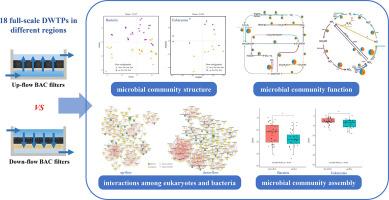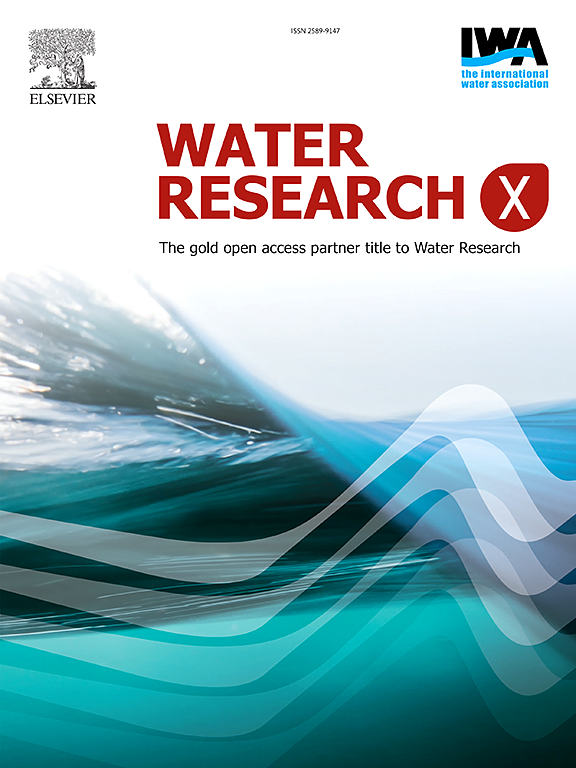流动配置形状微生物组组装和功能在全尺寸饮用水BAC过滤器
IF 8.2
2区 环境科学与生态学
Q1 ENGINEERING, ENVIRONMENTAL
引用次数: 0
摘要
为了解决传统的下流式生物活性炭(BAC)过滤器的挑战,上流式过滤器在饮用水处理厂(dwtp)中得到越来越多的应用,但其微生物特性和潜在的组装机制尚未得到充分的探讨。本研究首次全面比较了中国18个不同地理和操作环境的全规模dwtp上、下流式BAC过滤器中的细菌和真核生物群落、功能特征、生态相互作用和组装机制。尽管存在位点特异性差异,但在两种配置之间观察到不同的细菌和真核生物群落结构(ANOSIM, R=0.345-0.353, P < 0.05),突出了过滤器设计对微生物组的强烈影响。功能基因谱分析显示,上流式过滤器中碳、硫和氮代谢相关的高丰度途径显著富集(P<0.05),表明生物地球化学活性升高。HAllA和网络分析揭示了真核生物在构建微生物相互作用中的关键作用,并揭示了过滤器类型之间不同的跨域相互作用模式。群落组装分析显示,确定性过程主导BAC微生物组,在上游系统中具有显著更强的均匀选择(P < 0.05)。总之,这些发现为BAC过滤器微生物群提供了新的生态学见解,并支持更广泛地采用向上流设计来提高全尺寸dwtp的处理性能和微生物稳定性。本文章由计算机程序翻译,如有差异,请以英文原文为准。

Flow configuration shapes microbiome assembly and function in full-scale drinking water BAC filters
To address the challenges of traditional down-flow biological activated carbon (BAC) filters, up-flow filters have been increasingly applied in drinking water treatment plants (DWTPs), yet their microbial characteristics and underlying assembly mechanisms are not fully explored. This study presents the first comprehensive comparison of bacterial and eukaryotic communities, functional traits, ecological interactions and assembly mechanisms in up-flow and down-flow BAC filters across 18 full-scale DWTPs spanning diverse geographic and operational contexts in China. Despite site-specific variability, distinct bacterial and eukaryotic community structures were observed between the two configurations (ANOSIM, R=0.345-0.353, P < 0.05), highlighting the strong influence of filter design on microbiomes. Functional gene profiling revealed significant enrichment of high-abundance pathways related to carbon, sulfur, and nitrogen metabolism in up-flow filters (P<0.05), indicating elevated biogeochemical activity. HAllA and network analyses revealed the pivotal role of eukaryotes in structuring microbial interactions and uncovered distinct cross-domain interaction patterns between filter types. Community assembly analysis showed deterministic processes dominated BAC microbiomes, with significantly stronger homogeneous selection in up-flow systems (P < 0.05). Together, these findings provide new ecological insights into BAC filter microbiomes and support the broader adoption of up-flow designs to enhance treatment performance and microbial stability in full-scale DWTPs.
求助全文
通过发布文献求助,成功后即可免费获取论文全文。
去求助
来源期刊

Water Research X
Environmental Science-Water Science and Technology
CiteScore
12.30
自引率
1.30%
发文量
19
期刊介绍:
Water Research X is a sister journal of Water Research, which follows a Gold Open Access model. It focuses on publishing concise, letter-style research papers, visionary perspectives and editorials, as well as mini-reviews on emerging topics. The Journal invites contributions from researchers worldwide on various aspects of the science and technology related to the human impact on the water cycle, water quality, and its global management.
 求助内容:
求助内容: 应助结果提醒方式:
应助结果提醒方式:


